|

Winter 2002 (10.4)
Pages
76-79
Forgotten Foods
Comparison
of the Cuisines of Northern and Southern Azerbaijan
by Pirouz Khanlou
  Psychologists have long been fascinated
with the problem of whether it is heredity or, rather, environment
that plays the greater role in the development of the human species.
Numerous studies have focused on identical twins who were separated
at birth and grew up under different circumstances. In a sense,
Azerbaijanis are like that. Figuratively speaking, they've been
separated from their identical twin and brought up under entirely
different policies and circumstances, which, in turn, have influenced
their social, political, economic and religious outlook and upbringing.
These differences, in turn, have even impacted their cuisine
and the traditions related to food. Psychologists have long been fascinated
with the problem of whether it is heredity or, rather, environment
that plays the greater role in the development of the human species.
Numerous studies have focused on identical twins who were separated
at birth and grew up under different circumstances. In a sense,
Azerbaijanis are like that. Figuratively speaking, they've been
separated from their identical twin and brought up under entirely
different policies and circumstances, which, in turn, have influenced
their social, political, economic and religious outlook and upbringing.
These differences, in turn, have even impacted their cuisine
and the traditions related to food.
At the beginning of the 19th century, Azerbaijan was one territory
comprised of khanates and ruled locally under the jurisdiction
of the Persian Empire (known at the time as the Union of Gajar
States). Conflict broke out between Czarist Russia and Persia.
Two wars followed upon each other in short succession. Persia
was defeated and forced to cede considerable territory to Russia
in treaties signed at Gulustan (1813) and Turkmanchai (1828).
The territories now known as Georgia, Armenia and Nakhchivan
(an autonomous political region inside Azerbaijan) had to be
surrendered to Russia. Azerbaijan fared even worse because its
territory was split between both Russia and Persia. The Araz
River became the line of demarcation between what is known today
as Northern Azerbaijan (now the Republic)
and Southern Azerbaijan, which is in Iran.
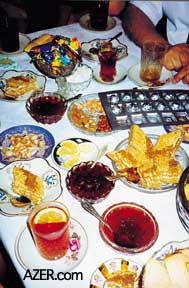  Left: Dinner tables in the Republic of Azerbaijan
are often spread with many small dishes that are within arm's
reach, as opposed to platters or bowls that are passed around
which is the more common practice among Azerbaijanis living in
Iran (Photo: Blair). Left: Dinner tables in the Republic of Azerbaijan
are often spread with many small dishes that are within arm's
reach, as opposed to platters or bowls that are passed around
which is the more common practice among Azerbaijanis living in
Iran (Photo: Blair).
Today, the greater population
of Azerbaijanis lives in Iran: only 8 million reside in the Republic,
which gained its independence from the Soviet Union in 1991.
An estimated 25-30 million Azerbaijanis live in Iran.
Nearly 200 years after being separated, these different "upbringings"
have led the "Azerbaijani twins" down the path to different
destinies and different realities-differences that we discovered
were reflected even in contemporary cuisine and eating habits.
Here Pirouz Khanlou suggests some of the major differences.
When the Bolsheviks captured
Baku in April 1920 and began establishing what would become the
Soviet Union, a political course was set in Northern Azerbaijan
that would forever impact every aspect of life-social, cultural,
economic and religious. In fact, the changes had such a profound
effect that they even impacted the traditional cuisine that had
emerged over thousands of years.
The Soviet Union under Lenin (1917 to 1924) began implementing
a planned economic system to unify the vast territory that made
up the largest country on earth, comprising 15 different countries.
These policies continued under Stalin (1924-1953), who launched
an intensive industrialization program that forced the collectivization
of agriculture. The New Economic Planning (NEP) organized the
agricultural industry systematically. Stalin set out to convert
the pre-revolution indigenous feudal agricultural system into
an industrialized system, mobilizing the country in a very short
period to create a self-sufficient economy with full provision
to feed its masses.
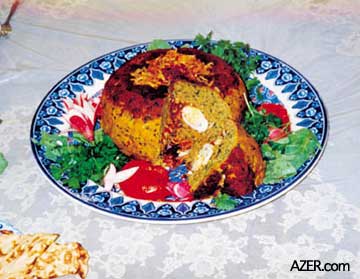  Left: Two examples of Azerbaijani dishes from
Iran, shown here as prepared by Pari Abadi in 2000. Above left:
Tabrizi kufta, a large meatball seasoned with herbs such as tarragon,
chives and cilantro, as well as mashed yellow peas, rice and
a variety of spices. The stuffing is composed of sour cherries,
prunes, walnuts and almonds mixed with fried onion and a hard-boiled
egg. Sometimes the kufta is so large that it has an entire chicken
inside. Left: Two examples of Azerbaijani dishes from
Iran, shown here as prepared by Pari Abadi in 2000. Above left:
Tabrizi kufta, a large meatball seasoned with herbs such as tarragon,
chives and cilantro, as well as mashed yellow peas, rice and
a variety of spices. The stuffing is composed of sour cherries,
prunes, walnuts and almonds mixed with fried onion and a hard-boiled
egg. Sometimes the kufta is so large that it has an entire chicken
inside.
It wasn't long before
this new centralized approach impacted the traditional cuisines
of the regions. Azerbaijan was no exception. Obviously, if a
traditional recipe called for major ingredients that were no
longer grown locally or were not accessible elsewhere in the
USSR, it wasn't long before that dish totally disappeared from
the table, and subsequently within a few generations even became
erased from memory.
In other cases, even when the ingredients were readily available,
if the preparation relied upon intensive, individualized manual
labor that could not be converted to mass production in factories,
these foods also disappeared. Such was the case of "sangak"-a
flat, wide, whole wheat sourdough bread, traditionally baked
individually in earthen tandir ovens. One of the major reasons
we even know about these foods today is that they are still prevalent
in Southern Azerbaijan.
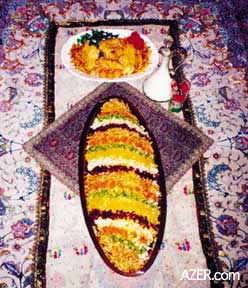  Below: Seven-Colored Pilaf, long-grain rice
decorated with a variety of ingredients, including pistachios,
almonds, orange peel, potatoes, saffron-flavored fried onion
and zarish (burgundy-colored sour dried berries). Photos: Pirouz
Khanlou Below: Seven-Colored Pilaf, long-grain rice
decorated with a variety of ingredients, including pistachios,
almonds, orange peel, potatoes, saffron-flavored fried onion
and zarish (burgundy-colored sour dried berries). Photos: Pirouz
Khanlou
In an effort to unify the peoples of the Soviet Union and create
the generic "Soviet man", there was an overbearing
tendency to impose Russian culture as a model, despite the fact
that Russia was only one of the 15 republics that made up the
USSR. Directives came from Moscow and always bore the mark of
Russians. Crops that were grown-cabbage, wheat, potatoes-essentially
catered to a Russian-based cuisine. Azerbaijani cooks had no
choice but to incorporate this produce into their own recipes,
to such an extent that Russian dishes like stuffed cabbage, borscht,
pork sausages and "Stolichni" (a mayonnaise-based salad),
though once foreign to Azerbaijanis' taste buds, soon became
ordinary, everyday fare.
Rice vs. Potato
One of the most pronounced differences between pre-Revolutionary
[1917] cuisine before in Northern Azerbaijan is the attitude
towards rice and potato. Rice is not an integral part of the
Russian diet; potato is. And subsequently, today in Northern
Azerbaijan, potato is featured more than rice.
Blame it on the choice of which vegetables should be cultivated
for the demise of rice in Northern Azerbaijan today. Russians
like cabbage and use it in borscht and stuffed cabbage rolls.
Although cabbage can be grown under various climactic conditions,
rice is much more restricted and requires a wet, subtropical
climate. Soviets were intrigued with the idea of guaranteeing
fresh cabbage in Moscow markets by early April, even before the
snows had melted. This was possible if they planted and transported
it from the southern climes of Azerbaijan. And thus the rice
and tea plantations located in the Lankaran region of Azerbaijan,
near the Iranian border, were replaced with cabbage farms. Tea
was imported from India and exchanged for Soviet military hardware.
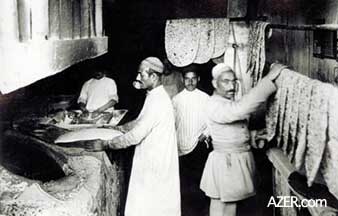  Left: Fresh sangak (whole-wheat sourdough
bread) as it was prepared in pre-Revolutionary Baku, before 1920.
The bread was baked on the sides of a tandir oven and then hung
up to dry. Sangak is still one of the favorite types of bread
in Iran, where an estimated 25-30 million Azerbaijanis live.
Photos: Azerbaijan National Photo Archives. Left: Fresh sangak (whole-wheat sourdough
bread) as it was prepared in pre-Revolutionary Baku, before 1920.
The bread was baked on the sides of a tandir oven and then hung
up to dry. Sangak is still one of the favorite types of bread
in Iran, where an estimated 25-30 million Azerbaijanis live.
Photos: Azerbaijan National Photo Archives.
Rice, which had been
so fundamental to Azerbaijani cuisine, became a rarity. A great
number of traditional rice dishes disappeared. Azerbaijanis became
potato and bread-eaters instead, and bread and dough-based dishes
like gutab, khangal and dushbara (dishes unknown in Southern
Azerbaijan cuisine) became the primary source of carbohydrates.
Rice was relegated to the role of luxury-a dish served only at
weddings and special occasions. Southern Azerbaijanis, however,
still enjoy rice on a daily basis, just as they have done for
centuries.
Fewer Spices
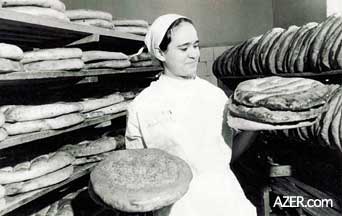  Left: During the Soviet period in Azerbaijan,
bread was mass-produced so traditional forms like the sangak
which are made by hand, soon were no longer available. A bakery
in Baku, Soviet era. Photos: Azerbaijan National Photo Archives. Left: During the Soviet period in Azerbaijan,
bread was mass-produced so traditional forms like the sangak
which are made by hand, soon were no longer available. A bakery
in Baku, Soviet era. Photos: Azerbaijan National Photo Archives.
The Soviet government
soon took control of all imported goods. As a result, the variety
of spices, which provided the nuances of flavor in Azerbaijani
cuisine, disappeared. Russian cuisine doesn't require many spices,
so the Soviet economic planners considered them superfluous and
non-essential. Tightly guarded political borders and the state-controlled
economic program prohibited spices from being imported from India
or the Middle East. And so it wasn't long before the spice bazaars,
with their exotic aromas and tantalizing colors, disappeared.
Today, there are no spice bazaars in the Republic and the range
of spices is extremely limited, especially in comparison with
Southern Azerbaijan, which is known for its famous spice bazaars
in the major cities of Tabriz, Urmia, Ardabil and Zanjan. The
Amir Bazaar in Tabriz is especially noteworthy because so many
merchants there deal in spices.
Consider saffron, an exceedingly expensive spice derived from
the delicate pistils of handpicked saffron stamens. Saffron provides
both flavor and golden orange coloring for rice pilaf. Soviets
may have considered it "bourgeois", and so it mostly
disappeared.
  Left: "Goy gutab" is typical cuisine
in Northern Azerbaijan. Ingredients includes salad types of greens.
Other typical gutabs are made of meat and pumpkin. Photo: Huseinzade Left: "Goy gutab" is typical cuisine
in Northern Azerbaijan. Ingredients includes salad types of greens.
Other typical gutabs are made of meat and pumpkin. Photo: Huseinzade
Without these spices,
food in Northern Azerbaijan became much plainer. To this day,
seasonings are primarily restricted to salt, pepper, turmeric
and a few other seasonings. In the South, Azerbaijanis still
season their dishes with a wide variety of spices, including
ginger, nutmeg, cinnamon, cardamom, caraway, and numerous spices
and mixtures unknown to the West.
Belief Systems
Many traditional ideas and beliefs have disappeared as well.
One dealt with the categories of "hot" and "cold"
foods, much like the beliefs of Ayurveda in India. These categories
refer to the effect food has on the body, not to the temperature
of the food itself.
If you ask an Azerbaijani in the North about the concept of "hot
and cold", you'll probably just get a blank expression.
But Azerbaijanis in Iran still believe in these classifications
and are careful to follow guidelines such as: don't mix hot with
hot, or cold with cold. Hot foods are said to raise the blood
pressure, cold foods, to lower it. Foods categorized as "cold"
include cucumber, eggplant, cabbage, tomatoes, lettuce
, yogurt, fish and rice. Foods
in the "hot" category include garlic, walnuts, grapes,
apples, honey, eggs, bread and red meat.
Another belief system, that of traditional medicine, has almost
totally disappeared in the North. Soviets tried to stamp out
the use of traditional medicine based on natural herbs. There
used to be herbal medicine shops called "attar", where
you could treat specific ailments with dried herbal mixtures.
Southern Azerbaijanis still have such shops.
In Hajibeyov's musical comedy of 1913, "O Olmasin, Bu Olsun"
(If Not This One, That One), the main character, Mashadi Ibad,
was one such bazaar merchant who sold herbal remedies. In the
1956 movie version, scenes of pre-Revolutionary Baku include
such shops (See AI 5.3, Autumn 1997; SEARCH at AZER.com).
These days, now that Azerbaijan has gained its independence,
people are beginning to experiment once again with treatments
derived from natural herbs, but very minimally, as Azerbaijanis
are more used to synthetic drugs.
Influence of Alcohol
The introduction of alcohol, specifically vodka, during the Soviet
period has shaped Northern cuisine in profound ways. For example,
take the presentation of food. In the Republic, when guests arrive,
they are ushered into a room with a long table covered with many
small plates, all within easy reach of every person. In Southern
Azerbaijan, however, there tends to be only one dish or platter
for each entrée, which is passed around.
Why so many small dishes? Perhaps it can be traced to the influence
of vodka. Traditionally, Azerbaijanis did not drink alcohol except
on rare occasions. In Iran, because of religious restrictions,
alcohol is illegal and few people drink. But Russians are known
to be hard drinkers who consider food an accompaniment to alcohol,
and not vice versa.
Russians have a saying: "Tea is not like vodka, which you
can drink a lot of". Russians have a tradition of serving
"zakuska"-appetizers set out on small plates, such
as pickles, salami, sausages, salted herring and mayonnaise-based
salads. Nibbling on such dishes enables a person to sustain drinking
for several hours.
Today, these same food practices continue in the Republic. This
may also explain why rice is served as the last entree at weddings,
long after the major entrees are finished. Were rice to be introduced
earlier, it could interfere with drinking because the guests
would be too stuffed.
Curiously, the role of vodka is evidenced in traditional expressions.
When Azerbaijanis describe a difficult task, they say, "I
had to eat a whole sheep to do this." The Russian version
is: "I had to drink half a liter (of vodka)". Azerbaijanis
in the Republic are inclined to offer a lot of toasts when drinking,
a pattern that is barely known in the South. (See "Tamada",
Autumn 1995, AI 4.3; SEARCH at AZER.com).
Mealtime
Another distinct difference relates to mealtimes. In Northern
Azerbaijan, there doesn't seem to be a regular schedule for families
to eat-no matter which meal. But in Southern Azerbaijan, fairly
routine patterns have been established, and all family members,
including fathers, are usually present-even for the noon meal.
Perhaps Soviet labor patterns are to blame for practices that
developed in Northern Azerbaijan and are still widespread today.
During the Soviet period, most women were required to work outside
the home. Husbands and wives were often involved in different
sectors, services or factories. Their different time schedules
did not allow coordination of family mealtimes.
Noon meals were often served in canteens and cafeterias in government
offices and factories. In the Republic today, it is not unusual
for family members to go to the kitchen and find food that has
been prepared earlier and serve themselves.
In the South, the majority of women still do not work outside
the home and thus are able to carry out the more traditional
homemaking tasks for their families, which could account for
more regular scheduling. Southern Azerbaijanis still break from
work during the hot midday hours. Schools are organized in shifts
"before lunch" and "after lunch", enabling
children to join family members, including their fathers, for
the noon meal.
Entertaining Guests
In the Republic, no matter what time of day or night a guest
arrives, it is assumed that food will be served. There is always
some sort of food available. However, in the South there tends
to be two categories of guests-those who are invited for a meal
such as lunch or dinner, and those who drop in for tea. Plans
are made several days in advance if guests are invited for meals
so that a wide range of dishes can be prepared.
On the other hand, having guests for tea is less formal. An assortment
of sweets will accompany the tea-seasonal fruit, cakes, chocolates,
hard candies or prepared sweets like the deep-fried "zulbia"
and "bamya" dipped in syrup and "Iris", a
chocolate flavored caramel-like candy. "Sharbat", a
fruit-flavored drink, may also be offered.
Religious Festivities
In Iran, two religious months based on the lunar calendar-Ramadan
and Maharram-play a dramatic role in traditions related to cuisine.
Ramadan (also known as "ramazan") is the strict observance
of fasting in Islam. People don't eat from sunrise to sunset-in
public, that is. This practice extends even to drinking water,
smoking or chewing gum. However, after sundown, relatives and
close family friends gather in each other's homes to break their
fasts. Tables are lavishly spread with appetizers and main courses.
This practice continues throughout the entire month of Ramadan
and, essentially, ends up being more like a feast than a fast-every
night.
Maharram, the month of mourning, marks the martyrdom of the third
Shiite Imam. This month is characterized by offering charity
to members of the community, especially those who are in need.
Wealthy people arrange large lunches and dinners either at home
or in local mosques. Food is shared with the poor and indigent.
Though both of these religious traditions were widely practiced
by Azerbaijanis, the Soviet takeover in Northern Azerbaijan resulted
in these practices becoming nearly extinct.
Forbidden Foods
Islam places restrictions on a few foods. Those permitted are
known as "halal". Forbidden foods are called "haram"
and include pork, alcoholic drinks, sturgeon and, therefore,
caviar. (Sturgeon falls into the broader category of "fish
with no scales". However, it should be noted that this prized
fish was declared "makruh" by Islamic clergy in 1979
for the first time in the Islamic world. "Makruh" implies
that permission has been granted to eat it, though it would be
better not to.)
These religious restrictions continue to impact the cuisine in
South Azerbaijan. During the Soviet period, with its secular
and anti-religious sentiments, such restrictions were eradicated,
and Northern Azerbaijanis today generally don't observe them.
For example, one of the most prized kababs in the Republic is
sturgeon. Despite the fact that both Iran and Azerbaijan Republic
have access to the Caspian, there are no traditional sturgeon
dishes in the South. White fish is more popular.
Dinner Guests
Even the practice of inviting guests over for dinner differs
between the North and South. For instance, in the South, guests
may be invited to sit on carpets as is the tradition, where a
"sufra"-tablecloth-is spread. But in the Republic-even
in remote villages-guests are always offered chairs to pull up
around a table.
In Iran, when the guests arrive, they are usually ushered into
the living room and offered tea or "sharbat", along
with sweets or fruit. The meal is not yet set out. Later on,
the guests usually move to another room to enjoy the main courses.
The small, cramped apartments that were built during the Soviet
period don't facilitate such hospitality. Most apartments do
not have a formal dining area; the small living room often doubles
as dining room and may even triple as bedroom. When guests arrive,
the food is already set out, with all sorts of small plates of
appetizers spread on the table. All guests immediately take their
places around the table, where they are likely to stay seated
for the duration of the evening.
Obviously, there are numerous other differences that could be
elaborated. But without a doubt, the political system imposed
by the Soviet system on Northern Azerbaijan has had a profound,
doubtlessly irreversible, effect on the country's socio-economic,
religious and cultural developments, including its traditional
cuisine.
Pirouz Khanlou, publisher of
Azerbaijan International, is an architect based in California
and an amateur gourmet cook. Marjan and Narges Abadi also contributed
to the research for this article.
___
Back to Index
AI 10.4 (Winter 2002)
AI Home
| Search | Magazine
Choice
| Topics
| AI Store | Contact us
Other Web sites
created by Azerbaijan International
AZgallery.org | AZERI.org | HAJIBEYOV.com
|









